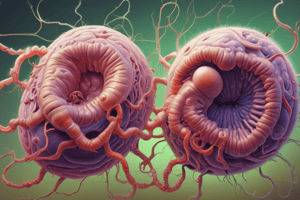Podcast
Questions and Answers
Prevention: prevent uses of human feces as ______.
Prevention: prevent uses of human feces as ______.
fertilizer
Prevention: prevent walking barefoot over contaminated moist ______.
Prevention: prevent walking barefoot over contaminated moist ______.
soil
PARASITE : Echinococcus multilocularis A small ______, 1.0-3.7 mm.long, of 3-5 segments.
PARASITE : Echinococcus multilocularis A small ______, 1.0-3.7 mm.long, of 3-5 segments.
tapeworm
PARASITE : Echinococcus multilocularis A small tapeworm, ______, of 3-5 segments.
PARASITE : Echinococcus multilocularis A small tapeworm, ______, of 3-5 segments.
PARASITE : Echinococcus multilocularis A small tapeworm, 1.0-3.7 mm.long, of ______ segments.
PARASITE : Echinococcus multilocularis A small tapeworm, 1.0-3.7 mm.long, of ______ segments.
PARASITE : ______ multilocularis A small tapeworm, 1.0-3.7 mm.long, of 3-5 segments.
PARASITE : ______ multilocularis A small tapeworm, 1.0-3.7 mm.long, of 3-5 segments.
______ : Echinococcus multilocularis A small tapeworm, 1.0-3.7 mm.long, of 3-5 segments.
______ : Echinococcus multilocularis A small tapeworm, 1.0-3.7 mm.long, of 3-5 segments.
Alyassiry helminthes are a type of ______
Alyassiry helminthes are a type of ______
Trematodes are commonly known as ______
Trematodes are commonly known as ______
Blood flukes infect the ______
Blood flukes infect the ______
Liver flukes mainly affect the ______
Liver flukes mainly affect the ______
Schistosoma and Fasciola hepatica are examples of ______
Schistosoma and Fasciola hepatica are examples of ______
The infective rhabditiform larvae are able to sense vibrations in the soil, heat, or carbon dioxide, and are able to use dendritic processes similar to cilia as: thermosensory, chemosensory, and ______ receptors to migrate towards a host for infection.
The infective rhabditiform larvae are able to sense vibrations in the soil, heat, or carbon dioxide, and are able to use dendritic processes similar to cilia as: thermosensory, chemosensory, and ______ receptors to migrate towards a host for infection.
The infective rhabditiform larvae are able to sense vibrations in the soil, ______, or carbon dioxide, and are able to use dendritic processes similar to cilia as: thermosensory, chemosensory, and mechanosensory receptors to migrate towards a host for infection.
The infective rhabditiform larvae are able to sense vibrations in the soil, ______, or carbon dioxide, and are able to use dendritic processes similar to cilia as: thermosensory, chemosensory, and mechanosensory receptors to migrate towards a host for infection.
The infective rhabditiform larvae are able to sense vibrations in the soil, heat, or ______, and are able to use dendritic processes similar to cilia as: thermosensory, chemosensory, and mechanosensory receptors to migrate towards a host for infection.
The infective rhabditiform larvae are able to sense vibrations in the soil, heat, or ______, and are able to use dendritic processes similar to cilia as: thermosensory, chemosensory, and mechanosensory receptors to migrate towards a host for infection.
The infective rhabditiform larvae are able to sense ______ in the soil, heat, or carbon dioxide, and are able to use dendritic processes similar to cilia as: thermosensory, chemosensory, and mechanosensory receptors to migrate towards a host for infection.
The infective rhabditiform larvae are able to sense ______ in the soil, heat, or carbon dioxide, and are able to use dendritic processes similar to cilia as: thermosensory, chemosensory, and mechanosensory receptors to migrate towards a host for infection.
The infective rhabditiform larvae are able to sense vibrations in the soil, heat, or carbon dioxide, and are able to use dendritic processes similar to cilia as: ______, chemosensory, and mechanosensory receptors to migrate towards a host for infection.
The infective rhabditiform larvae are able to sense vibrations in the soil, heat, or carbon dioxide, and are able to use dendritic processes similar to cilia as: ______, chemosensory, and mechanosensory receptors to migrate towards a host for infection.
Microscopy Laboratory confirmation of infection can be made by finding the eggs in the feces after an iodine stained, formol-ether concentration method for Schistosoma mansoni and Schistosoma japonicum. When eggs cannot be found in the feces, a rectal biopsy can be examined. Schistosoma hematobium can be found in ______ or feces.
Microscopy Laboratory confirmation of infection can be made by finding the eggs in the feces after an iodine stained, formol-ether concentration method for Schistosoma mansoni and Schistosoma japonicum. When eggs cannot be found in the feces, a rectal biopsy can be examined. Schistosoma hematobium can be found in ______ or feces.
Alyassiry Laboratory Diagnosis involves the examination of feces for eggs of Schistosoma mansoni and Schistosoma japonicum after an iodine stained, formol-ether concentration method. If eggs are not found, a ______ biopsy can be performed.
Alyassiry Laboratory Diagnosis involves the examination of feces for eggs of Schistosoma mansoni and Schistosoma japonicum after an iodine stained, formol-ether concentration method. If eggs are not found, a ______ biopsy can be performed.
To confirm Schistosoma mansoni and Schistosoma japonicum infection, one can look for eggs in the feces using an iodine stained, formol-ether concentration method. Alternatively, a ______ biopsy can be conducted if eggs are not detected.
To confirm Schistosoma mansoni and Schistosoma japonicum infection, one can look for eggs in the feces using an iodine stained, formol-ether concentration method. Alternatively, a ______ biopsy can be conducted if eggs are not detected.
In the diagnosis of Schistosoma hematobium, examination of ______ or feces can reveal the presence of the parasite.
In the diagnosis of Schistosoma hematobium, examination of ______ or feces can reveal the presence of the parasite.
Finding eggs in the feces after an iodine stained, formol-ether concentration method is a common way to confirm infection with Schistosoma mansoni and Schistosoma japonicum. If eggs are not found, a ______ biopsy can be performed for further evaluation.
Finding eggs in the feces after an iodine stained, formol-ether concentration method is a common way to confirm infection with Schistosoma mansoni and Schistosoma japonicum. If eggs are not found, a ______ biopsy can be performed for further evaluation.
Flashcards are hidden until you start studying




